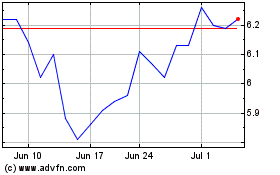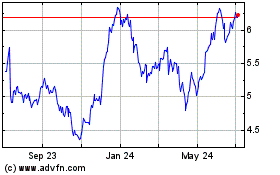Stockholm tops Ericsson Networked Society City Index 2016
June 20 2016 - 4:11AM

-
Stockholm leads London, Copenhagen, Singapore
and Paris in Networked Society City Index 2016
-
Significant improvements for Barcelona, Istanbul
and Jakarta in this year's index, while Hong Kong, Moscow and Dubai
drop
-
Index measures the performance of 41 cities in
sustainable urban development and ICT maturity
Ericsson (NASDAQ: ERIC) has named Stockholm as the
top-ranking city in the Networked Society City Index 2016, followed
by London, Copenhagen, Singapore and Paris.
The index measures the performance of 41 cities
from around the world from two perspectives: sustainable urban
development and ICT maturity1.
Stockholm is ranked number one
in the sustainable urban development part of the index, closely
followed by Copenhagen, Helsinki and Paris. London ranks top in the
ICT part of the index, replacing Stockholm, which now ranks second
before Singapore on third place.
Cities that have noticeably moved up the Networked
Society City Index 2016 ranking, compared with the 2014 index,
include Barcelona, Istanbul and Jakarta. However, Hong Kong, Moscow
and Dubai dropped in the ranking. In general, cities with low ICT
maturity tend to mature faster than cities with higher ICT
maturity, which indicates the presence of a catch-up effect.
Other highlights from the Networked Society City
Index 2016 include:
-
There is a positive correlation between social
and economic development and increasing ICT maturity.
-
ICT is not only critical to socioeconomic
progress, but can help decouple this progress from an increased
environmental footprint in favor of more sustainable
development.
-
Smart city planning will be critical to
achieving several of the United Nations Sustainable Development
Goals (SDGs). For example, cities will be instrumental for the
advancement of climate action, poverty reduction, better health and
education, as well as improved social and financial
inclusion.
-
A number of actions are essential for cities to
go beyond smart cities of today and become more sustainable:
including ICT as a basic infrastructure in the investment plans;
creation of enabling regulatory environments that encourage the
adoption of ICT; holistic approaches to integrating ICT across
various sector planning, such as transport, energy and public
safety; and collaboration between cities.
Erik Kruse, Head of Ericsson Networked Society
Lab, says: "UN-Habitat estimates that 70 percent of the world's
population will reside in urban areas by 2050. Many smart city
initiatives to date have mainly used ICT to optimize existing
systems and behaviors, for example, intelligent transport.
"Instead, cities need to rethink existing
structures to fully grasp the potential of ICT to make sure that
"smart" is in fact sustainable. The future Networked Society city
is characterized by resiliency, collaboration, participation and
mobility, which are essential for ensuring our cities are
attractive, sustainable and vibrant places."

1) ICT maturity
and sustainable urban development are both divided into three
dimensions. ICT maturity is broken down into ICT infrastructure,
ICT affordability and ICT usage. Sustainable urban development is
based on the Triple Bottom Line dimensions - social, economic and
environmental sustainability.
NOTES TO EDITORS
Read the full report and explore the Networked
Society City Index interactive tool here
For media kits, backgrounders and high-resolution
photos, please visit www.ericsson.com/press
Ericsson is the driving force
behind the Networked Society - a world leader in communications
technology and services. Our long-term relationships with every
major telecom operator in the world allow people, business and
society to fulfill their potential and create a more sustainable
future.
Our services, software and
infrastructure - especially in mobility, broadband and the
cloud - are enabling the telecom industry and
other sectors to do better business, increase efficiency, improve
the user experience and capture new opportunities.
With approximately 115,000
professionals and customers in 180 countries, we combine global scale with technology and services
leadership. We support networks that connect more than 2.5 billion
subscribers. Forty percent of the world's mobile traffic is carried
over Ericsson networks. And our investments in research and
development ensure that our solutions - and our customers - stay in
front.
Founded in 1876, Ericsson has its
headquarters in Stockholm, Sweden. Net sales in 2015 were SEK 246.9 billion (USD 29.4 billion). Ericsson is
listed on NASDAQ OMX stock exchange in Stockholm and the NASDAQ in
New York.
www.ericsson.com
www.ericsson.com/news
www.twitter.com/ericssonpress
www.facebook.com/ericsson
www.youtube.com/ericsson
FOR FURTHER INFORMATION, PLEASE CONTACT
Ericsson Corporate Communications
Phone: +46 10 719 69 92
E-mail: media.relations@ericsson.com
Ericsson Investor Relations
Phone: +46 10 719 00 00
E-mail: investor.relations@ericsson.com
Press Release Networked Society
City Index 2016
Report: Ericsson Networked Society City Index 2016
This
announcement is distributed by NASDAQ OMX Corporate Solutions on
behalf of NASDAQ OMX Corporate Solutions clients.
The issuer of this announcement warrants that they are solely
responsible for the content, accuracy and originality of the
information contained therein.
Source: Ericsson via Globenewswire
HUG#2021689
Ericsson (NASDAQ:ERIC)
Historical Stock Chart
From Mar 2024 to Apr 2024

Ericsson (NASDAQ:ERIC)
Historical Stock Chart
From Apr 2023 to Apr 2024
